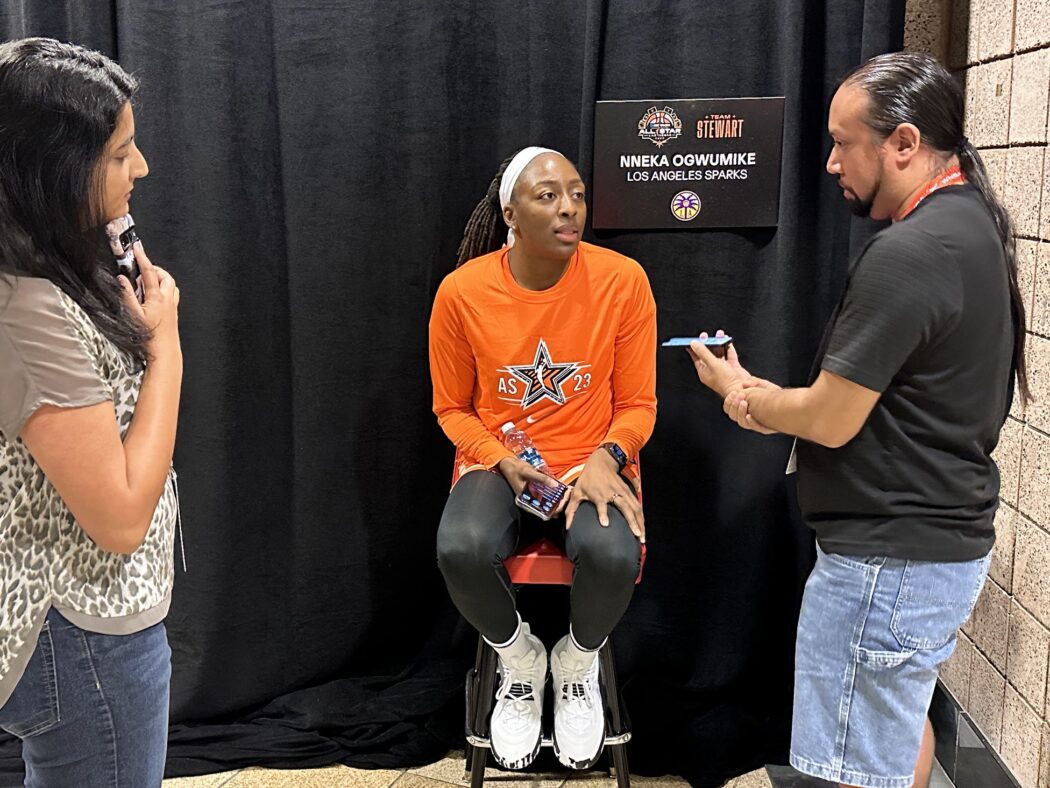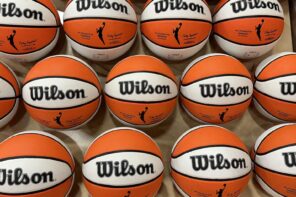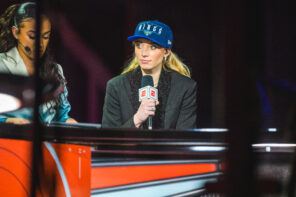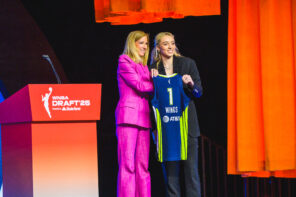When we launched Beyond The W in the mid 2010s, the WNBA used to strain just to get various media to cover the sport. This includes marquee events such as the draft, All-Star weekend and the playoffs/Finals.
The 2023 WNBA season recently concluded – and it is clear to say that the W no longer has those problems of getting press to cover these big events.
The media areas for these events are full – and on many occasions the reporters that diligently cover the W are doing so on their own dime to bring attention to a sport that is growing in terms of popularity and coverage.
We – and the rest of our WNBA family – recently got wind of a Washington Post article that details how the league and its teams still are straining for more media coverage. At the same time, the increased media attention the W has received is leading to an increasingly strained relationship between press and player.
There are many layers to this, but here is where we see things as a Black-led independent outlet.
First of all, as we penned prior to the 2023 draft, the WNBA needs to be very careful in terms of the types of coverage it is asking for. With more and more writers and cameras on the W and its players, the WNBA ought to understand not to stonewall those outlets (such as ours) that have been ride or dies for this league and its players in favor of more mainstream media outlets.
A perfect example of this is when Adrian Wojnarowski (ESPN) or Shams Charania at The Athletic are breaking stories that should be reserved for Rachel Galligan at Winsidr or Khristina Williams at Girls Talk Sports TV. Without the Williams’ and Galligans of the world busting their you-know-whats for the W, its teams and players over the years, Woj and Shams would probably not be as interested in the W as they are currently.
Do not get us wrong – Woj and Shams are great reporters in their own rights. But the W cannot be operating from a perspective of seeking prestige or seeking validation simply because it wants to say that bigger budgeted (and white-led, must we add) outlets are interested in coverage at the expense of limiting coverage to smaller independent media – many of which are Black-led.
We firmly believe that if the W were to hypothetically do this that it would take the league back to the dark days when teams were regularly folding year in and year out. That is not the correct course the W should take and it would be a massive setback for women’s sports as a whole.
That is not to say that there are not those at those bigger outlets such as LaChina Robinson and Terrika Foster-Brasby at ESPN who also do a great job and are standard bearers for Black women in sports media. If one has not listened to their latest Around the Rim episode – it is a must listen. They recap – among other things – the Las Vegas Aces’ win over the New York Liberty, Teresa Weatherspoon being hired by the Chicago Sky, Nate Tibbetts being hired by the Phoenix Mercury and A’ja Wilson’s close encounter with Usher at one of his Vegas residency concerts.
Also – about those mainstream media outlets. Do not get us wrong. We firmly welcome them to the cookout because we believe in the “big tent” philosophy. The more the merrier. But more big budget outlets need to do what the Washington Post does with Kareem Copeland and what the Chicago Sun-Times does with Annie Costabile and hire dedicated beat writers that travel to away games not to mention big events like the draft, All-Star and (if necessary) the playoffs and Finals.
Sidenote: the Sun-Times was bought out by public radio station WBEZ 91.5 and Chicago Public Media last calendar year. Oh – one more thing. Make sure those beat writers are paid full time salaries as well. No “freelance” or “contract” mumbo jumbo. Full. Time. With. Benefits. And. PTO.
Big budgeted media outlets have also been notorious in hiring interns to work WNBA games. While this does allow those interns to get some valuable experience under their belts, we are of the belief that all internships should be paid as well and it should be a gateway to full-time employment. Covering the WNBA is big-time work and it is time these mainstream big-budgeted outlets start treating as such with it being reflected in the pay.
Also – speaking of All-Star, we remember vividly the stories of reporters – particularly Black women – who got on Twitter and talked about how uncomfortable their experiences were during this past year’s festivities in Las Vegas. That is something we all have to be better at given how women – particularly Black women – have proven themselves to be the heartbeat of coverage. That is the case within the WNBA’s press corps and it is the case in other sports as well – not to mention it is appropriate given Black women are the conscience of our society as a whole.
Another aspect that has to be mentioned is the access part of it. There are plenty of reporters who are lamenting that the W is denying them access by denying locker room access to players post game. The WNBA and its teams are making up for this by having PR staff wait outside of locker rooms and having players speak to press outside of locker rooms if certain media members ask.
This is a change that we, personally, have no issue with. One would think this would especially be the case for men covering the W that it would be an uncomfortable experience to go into a locker room full of tired, sweaty women – some of whom likely are not fully clothed – and asking a bunch of probing questions about the game that took place.
Note to media – we understand you want quotes from these players, but at the end of the day, they are still human beings regardless of if they are or are not wearing a WNBA uniform.
This gets to another issue that plenty of larger media may feel skittish about touching. The reality of the situation is the WNBA is around 80% Black and a sizable number of its players also identify as LGBTQIA+.
If this increase in WNBA attention is only going to lead to more white males landing jobs to cover the W – and the W giving preferential treatment to those outlets – one would think it would be common sense that players would feel a certain kind of way about a potential lack of diversity in credentialed press.
Liberty beat writer Myles Ehrlich of Winsidr and Tyler DeLuca of The Committee Sports Group are shining examples of men who understand that they are in a predominantly Black space and push for more diversity among media – not less. Ehrlich and DeLuca are progressive enough to understand this discrepancy overall with WNBA (and sports) media as a whole.
After all, DeLuca is with an outlet that has somewhat made calling out these discrepancies between how Black and white players are covered in the media part of its identity. In addition, DeLuca himself is based in Oklahoma – a state that is not exactly a beacon of progressivism.
Not to mention it is those Black-led outlets that are more than likely to take the approach we at Beyond The W, Ari Chambers at Bleacher Report and Williams at Girls Talk Sports have taken. That is to cover the cultural significance of the WNBA where we learn more about their music tastes, fashion tastes and off-court initiatives they partake in.
We firmly believe that is the approach the players want and that is the approach the fans want. Players want to feel comfortable and have an opportunity let their hair down so they can talk more about what artists they listen to get them pumped prior to a game or who styled their fits on the orange carpet. Not all WNBA coverage has to be traditional ala the Howard Megdals, Doug Feinbergs, Alexa Philoppous and M.A. Voepels of the world.
It is as simple as this – the mainstream media outlets who are becoming part of the WNBA’s press corps have to understand that these players will likely warm up to media as long as they see themselves represented in that media.
But teams, players, coaches and the league as a whole have to understand that there is a difference between journalism and public relations. Players themselves ought to know this given many including Candace Parker (TNT/NBA TV), Chiney Ogwumike (ESPN) and now Aliyah Boston (Big Ten Network) work media gigs as analysts during the offseason.
All 12 teams – and the league itself, of course – have their own staff that they pay for the purposes of PR. Bryan Flannery at the Liberty, Gabrielle Ducharme at the Sparks and Giggy Maxwell at the Aces come to mind. In the league’s case, some of those crossover from the NBA side.
The WNBA says it wants even more coverage of the league than what it has received over the last few years. League and teams need to understand that there will be occasions when that coverage is not always candies like Cameo and lollipops like Lil Wayne.
If a team is struggling – as was the case with our four lottery teams (Los Angeles Sparks, Seattle Storm, Phoenix Mercury, Indiana Fever), that will be reflected in the coverage. The Washington Post referenced how Chicago Sky players began getting testy with press when they were going through their struggles but eventually made the postseason as an eight seed.
It is easy to talk to media when winning. Not so much when a team is losing as the Sky were expected to do plenty of this past season with Candace Parker, Allie Quigley and Courtney Vandersloot no longer being on the team. Not to mention the Sky underwent a coaching change midseason.
The Sky overcame plenty of adversity to make the playoffs and players need to understand that as the WNBA grows (especially in its big markets) the coverage will start to feel like being a team playing in the W’s third biggest market.
Much was made about how a few Liberty players (Sabrina Ionescu, Jonquel Jones, Betnijah Laney) did not speak to the media after their Finals loss – and how the Mercury did not speak at all to the press following their Finals loss to the Sky at the conclusion of the 2021 season. New York did have Breanna Stewart and Courtney Vandersloot available as well as coach Sandy Brondello (who also coached Phoenix in 2021).
For this, we understand. Again – there has to be a human element to sports coverage that some who undertake this profession forget. It is one thing to lose in the regular season or in an earlier playoff round. It is another to suffer defeat in the Finals – especially as heartbreaking as the Lib loss was.
The Liberty had a lead for much of that Game 4 in front of around 17,000 fans at a sold-out Barclays Center. A’ja Wilson’s 24 points and 16 rebounds were the difference in clinching a second consecutive championship for Vegas. Probably the last thing those Liberty players wanted to do was answer queries from the media.
New York was fined $25,000 for declining interviews. That is lint in the pockets of Joe and Clara Tsai.
Is it part of a WNBA player’s job to talk to media? Yes. Are these players still humans with real, competitive human emotions at the end of the day. Also yes.
This is a very perplexing (and somewhat vexing) piece for us to pen because it was not that long ago that we did indeed pen a shoutout to those in the WNBA’s press corps (both indie and mainstream) that did a great job this past season. The reality of the situation is while they are doing a great job and have been deserving of their flowers, there are questions about the W’s relationship with certain outlets.
This can be a good and bad problem to have. This sort of dynamic is better than the dynamic the W used to encounter when there were almost no press at these events. And a person’s perspective on how they see the dynamic between the league and the media will be decided on their area of coverage.
All 12 teams, of course, have their own distinct protocols regarding media – as does the league itself. One who may be a beat writer for a team may have a different perspective than someone who covers the entire WNBA. Someone who covers the Minnesota Lynx may have a different perspective than someone who covers the Atlanta Dream. Someone who covers the Connecticut Sun may have a different perspective than someone covering the Dallas Wings. Someone covering the Washington Mystics may have a different perspective than someone covering any of the aforementioned teams.
The bottom line is WNBA coverage will never be perfect because humans will never be perfect – but there are plenty of us within the W’s press corps including Chambers, Ehrlich, Williams, DeLuca, Copeland, Costabile, Robinson, Foster-Brasby and ourselves that are working diligently to make it as best as we can (many of whom on a tight dime).
With the offseason having commenced, this is the perfect time for those conversations to begin. We have identified the problems and now we can use that big tent philosophy to come up with solutions. Particularly given how inclusive the W’s press corps is more than those of other sports and leagues we are confident those solutions will come to pass.




